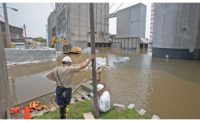Water Projects
California Water Agencies Outline $3.2B Plan for Central Valley Flood Prevention Projects

According to the USACE, Lathrop on the San Joaquin River is one of the most vulnerable cities in the country to flooding.
Photo by Paul Hames / California Department of Water Resources
California water officials are urging a $3.2-billion investment in flood prevention projects over the next half decade to safeguard the Central Valley; particularly communities on the San Joaquin River that are considered among the most vulnerable in the nation.
The California Dept. of Water Resources (DWR) and the Central Valley Flood Protection Board (CVFPB) called for the combined investment from federal, state and local agencies to meet the recommendations of the Central Valley Flood Protection Plan (CVFPP) 2022 Update. The plan would require an investment of $25 billion to $30 billion over the next 30 years, officials say.
The CVFPP, prepared by the DWR and adopted by the CVFPB, guides California's management of flood risk in areas protected by the State Plan of Flood Control. The plan is updated every five years, prioritizing flood management investment over a 30-year planning horizon.
The current update of CVFPP includes plans to repair, rehabilitate or improve 361 miles of urban and 120 miles of non-urban levees. It also involves feasibility studies for new projects in collaboration with the U.S. Army Corps of Engineers (USACE) and significant flood prevention investments in the San Joaquin River region.
Officials emphasize the importance of investing in resilience through projects like the $1.39-billion San Joaquin Lower River Project, currently undergoing a Phase II feasibility study by the USACE. These projects are crucial for enhancing flood resilience for cities such as Stockton, Manteca and Lathrop that have the lowest level of flood protection among major U.S. river cities, according to Corps officials.
CVFPP initiatives are also seen as critical for rural and agricultural communities in coordinating and accessing funding for flood prevention projects. Regional flood priorities, safety plans, evacuation plans, training and supplies can be developed through the plan, as highlighted by Meegan Nagy, deputy manager of Reclamation District 108.
Collaboration between federal, state and local partners, as outlined in the CVFPP 2022 Update, has proven beneficial for cities like Sacramento, which has seen significant investments in flood control infrastructure. Rick Johnson, executive director of the Sacramento Area Flood Control Agency, cites the completion of three construction projects and the ongoing work on three more, with over $5 billion in funding.
One project is the $114.4-million effort to raise the Folsom Dam by 3.5 feet awarded to a joint venture of Shimmick Construction and California Engineering Contractors in April. The contract also includes elevating the structure’s left- and right wing dams and modifying its eight spillway gates by adding top seals, strengthening the gates and raising the gate piers.
The USACE also recently chose Granite Construction for another key flood mitigation project in the region, the $172.9-million widening of the Sacramento Weir.
While the CVFPP's planning area encompasses 1,600 miles of state and federal levees and extensive water bypasses and floodways in the San Joaquin River and Sacramento River basins, counties in the Tulare River Basin are managed separately. Efforts to mitigate floods caused by high seasonal snowmelt in the Sierra Nevada Mountains are underway in Tulare, Kings, Kern and Fresno counties.
DWR Director Karla Nemeth encourages the inclusion of these outlying counties in the CVFPP, stating that participation would greatly benefit their communities and provide a significant advantage in understanding the system, addressing climate change impacts, and adopting a regional perspective.



